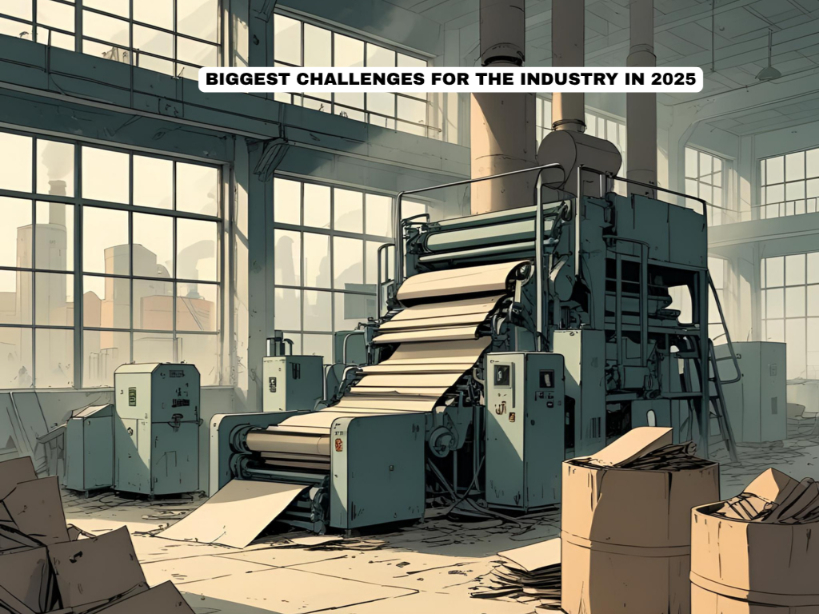PAPER PREDICAMENTS: THE BIGGEST CHALLENGES FOR THE INDUSTRY IN 2025
The pulp and paper industry is no stranger to transformation. What was once a market defined by demand for newspapers and office paper has now evolved into a high-stakes arena balancing sustainability, cost efficiency, and technological advancements. As we dive into 2025, the industry is facing a tidal wave of challenges—some expected, some unprecedented.
Here’s a deep dive into the top 10 hurdles that will shape the future of paper, and the strategies businesses must adopt to stay afloat.
1.SUSTAINABILITY: NO LONGER A CHOICE, BUT A NECESSITY
The green revolution is here, and for paper manufacturers, compliance isn’t optional—it’s survival. Sustainability is the battleground where companies will either thrive or perish.
The Pressure Points:
- Energy Intensity: High power consumption translates to hefty production costs and carbon footprints.
- Water Dependency: Paper production is water-intensive, leading to environmental scrutiny.
- Waste Management: Poor disposal methods result in regulatory penalties and reputational damage.
- Carbon Emissions: Companies must meet stricter climate targets or face heavy fines.
The Game Plan:
- Invest in renewable energy to power operations.
- Improve recycling processes to cut waste.
- Develop biodegradable paper products for packaging and beyond.
2.SUPPLY CHAIN & RAW MATERIAL PRICE TURBULENCE
From pulp to chemicals, material costs are at an all-time high. Global supply chain disruptions, economic uncertainty, and geopolitical tensions only add to the volatility.
Survival Strategies:
- Explore alternative fiber sources like bamboo, hemp, and agricultural waste to reduce reliance on virgin pulp.
- Scale up recycling to offset raw material price hikes.
- Diversify suppliers to mitigate risks from trade restrictions or transportation breakdowns.
3.TIGHTER ENVIRONMENTAL REGULATIONS: THE COMPLIANCE CRUNCH
Governments worldwide are tightening policies on emissions, water use, and deforestation. Companies that don’t adapt face steep fines, operational restrictions, and public backlash.
The Smart Play:
- Deploy waste-reduction tech to meet compliance.
- Invest in carbon capture and energy-efficient processes.
- Shift towards sustainable packaging solutions to align with evolving consumer demands.
4. THE DEFORESTATION DEBATE: FINDING GREENER ALTERNATIVES
Deforestation remains a pressing issue, with the industry under fire for unsustainable forestry practices.
How to Build a Sustainable Supply Chain:
- Utilize non-wood fibers and agricultural byproducts.
- Strengthen reforestation efforts and responsible forestry programs.
- Enhance traceability systems to verify sustainable sourcing.
5.DIGITAL TRANSFORMATION: A NEW ERA FOR PAPER MANUFACTURING
Automation, AI, and IoT-driven manufacturing are redefining the industry. Companies that resist digitalization risk inefficiency and higher operational costs.
Future-Ready Tech:
- AI-powered sensors to optimize energy use.
- Predictive maintenance to reduce machine downtime.
- Big data analytics to forecast production trends.
6. THE DIGITAL AGE VS. PAPER-BASED PRODUCTS
As digital media continues to dominate, traditional paper markets like newspapers, magazines, and office paper are declining.
Countermeasures:
- Invest in high-growth segments like biodegradable packaging.
- Expand into medical and security-grade paper production.
- Develop premium, sustainable paper products that cater to niche markets.
7.THE WORKFORCE CONUNDRUM: TALENT SHORTAGES IN THE INDUSTRY
An aging workforce and declining interest from younger generations have led to a labor crunch.
Solutions for a Stronger Workforce:
- Automate repetitive processes to reduce reliance on manual labor.
- Enhance training and career development programs.
- Improve workplace safety and job satisfaction to attract talent.
8. ENERGY CRISIS & THE URGENT NEED FOR MODERNIZATION
Paper mills are notorious for their energy consumption. As energy prices soar, companies must invest in smarter solutions.
Efficiency Upgrades:
- Upgrade turbines and boilers for better fuel efficiency.
- Implement digital twins for predictive maintenance and process optimization.
- Explore biofuels and alternative energy sources.
9. THE MARKET DEMAND ROLLERCOASTER
Consumer preferences, economic downturns, and unexpected global events make demand forecasting a challenge.
Future-Proofing Strategies:
- Develop adaptable production lines to swiftly respond to shifts in demand.
- Expand into emerging paper product categories.
- Strengthen industry collaborations to stabilize supply and demand dynamics.
10. THE FUTURE OF PAPER: EMBRACING INNOVATION &
SUSTAINABILITY
Despite its challenges, the paper industry is on the cusp of an exciting transformation. The push for sustainability is driving innovation like never before.
What’s Next?
- Multi-fiber paper blends for more sustainable production.
- Cutting-edge recycling technologies for a circular economy.
- Greater alignment with global environmental policies and carbon neutrality goals.
FINAL THOUGHTS FROM THE CONIFEROUS
2025 isn’t just another year, it’s a pivotal moment for the pulp and paper industry. Businesses must reinvent themselves, embracing sustainability, digitalization, and strategic innovation to thrive in an ever-changing landscape.
How is your business preparing for these challenges? Let’s create a sustainable future together! 🌿✨


